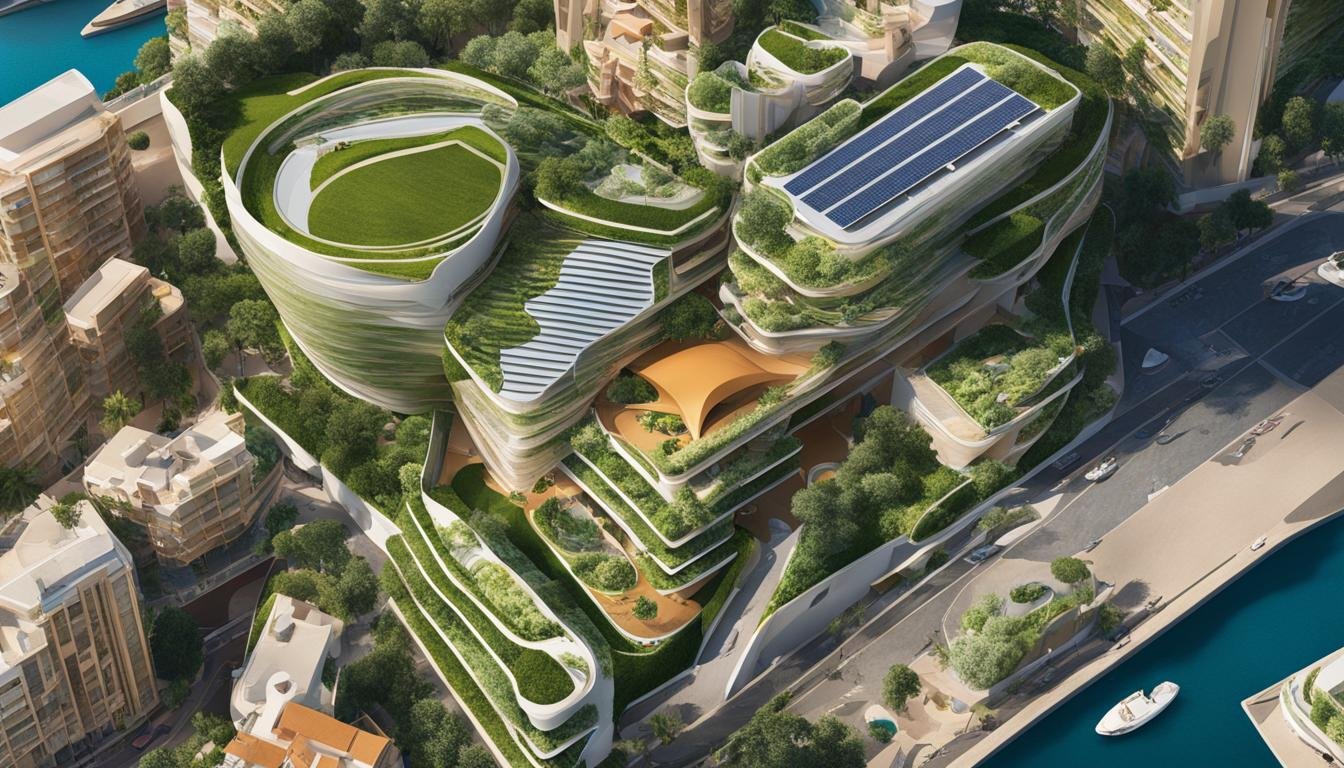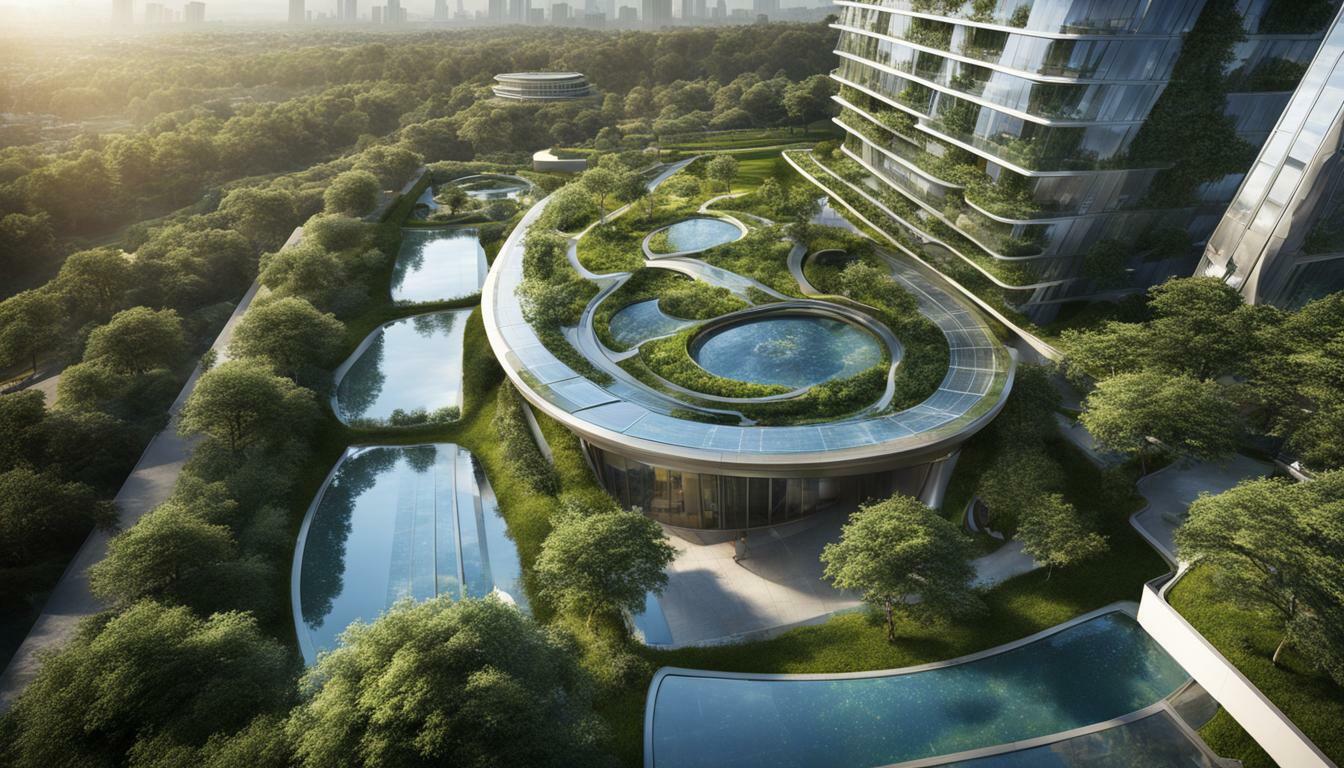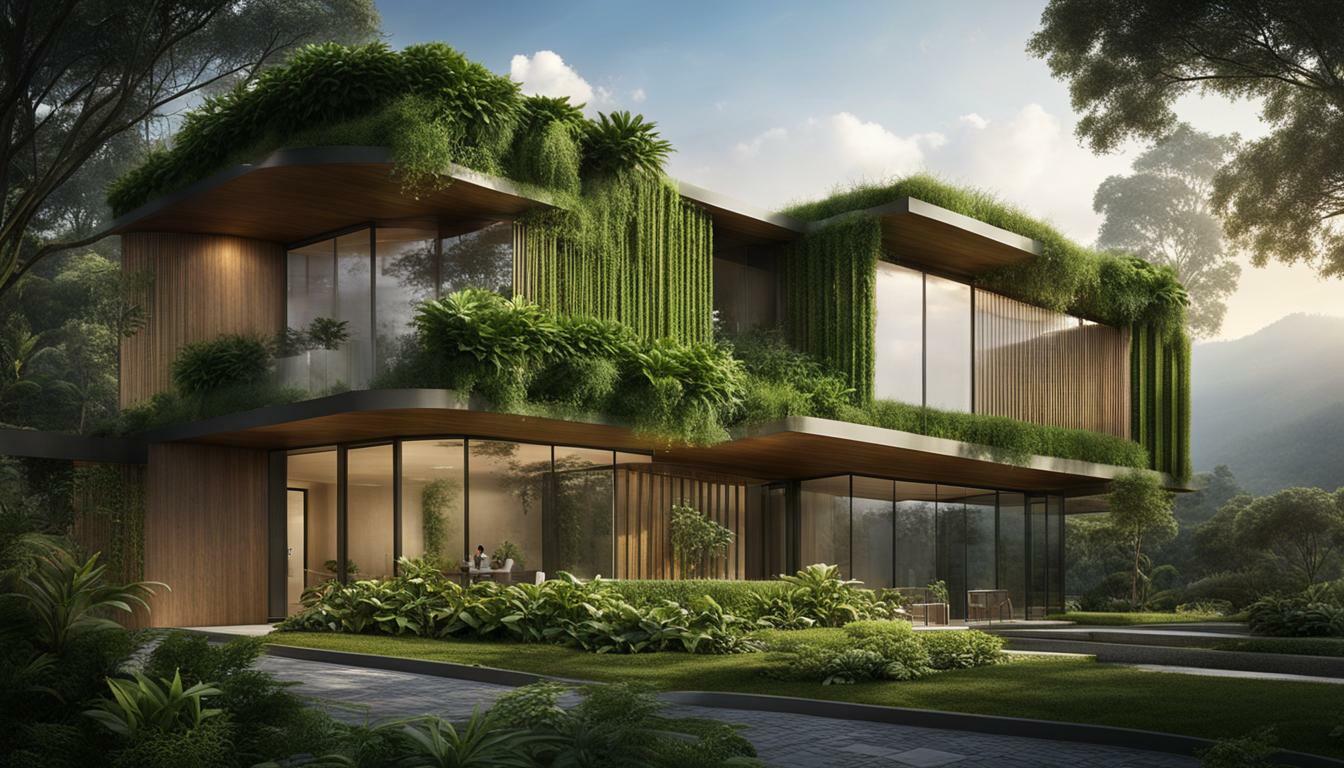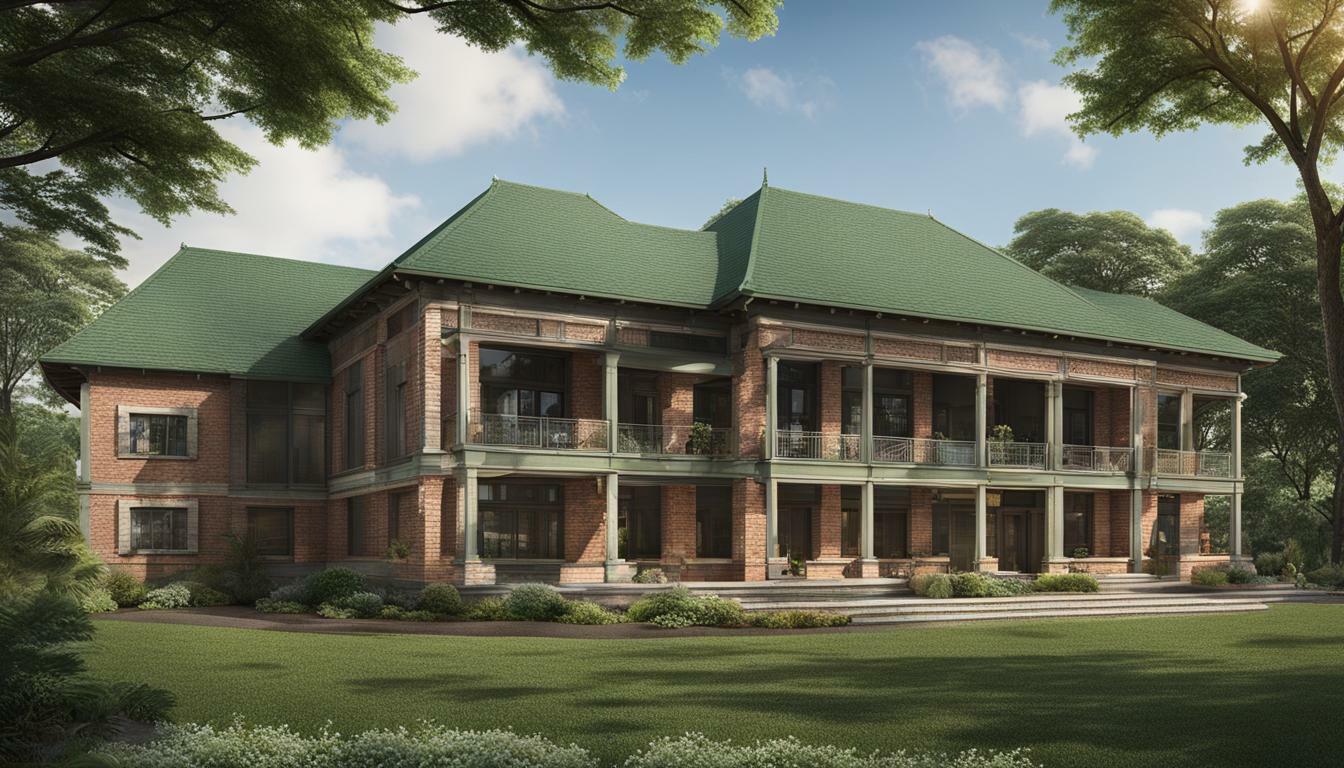Mongolia Top Green Buildings: Leading the Way in Sustainable Architecture and Construction
Mongolia is at the forefront of eco-friendly architecture and sustainable construction, with a strong focus on environmentally-friendly buildings and sustainable urban development. The country is committed to promoting green design and using green building materials to create energy-efficient structures that prioritize environmental conservation. From residential to commercial projects, Mongolia is embracing sustainable architecture and eco-conscious construction practices.
Key Takeaways:
- Mongolia is dedicated to sustainable urban development and eco-friendly architecture
- The country prioritizes the use of green building materials and energy-efficient designs
- Environmental conservation and reducing greenhouse gas emissions are central objectives
- Mongolia is transforming ger areas into low-carbon, climate resilient eco-districts
- The Ulaanbaatar Green Affordable Housing and Resilient Urban Renewal Project (AHURP) aims to deliver 10,000 energy-efficient and affordable housing units
Ulaanbaatar Green Affordable Housing and Resilient Urban Renewal Project (AHURP)
The Ulaanbaatar Green Affordable Housing and Resilient Urban Renewal Project (AHURP) is a significant initiative in Mongolia that aims to promote sustainable and affordable housing. The project focuses on delivering 10,000 green housing units that are energy efficient, affordable, and designed to maximize the use of renewable energy sources. Its ultimate goal is to transform the ger areas of Ulaanbaatar into eco-districts that are low-carbon and climate resilient.
The AHURP is currently in the detailed design stage and is expected to be completed by 2026. It is a collaborative effort between the Municipality of Ulaanbaatar and various stakeholders. The project’s scope includes redeveloping 100 hectares of ger areas into eco-districts, providing not only sustainable housing options but also commercial areas, social facilities, and greenhouses. The anticipated completion date of 2026 highlights the long-term commitment and dedication to creating a livable and environmentally-conscious city.
Under the AHURP, the Municipality of Ulaanbaatar offers a range of services to achieve its sustainability goals. These services include sustainability goal and key performance indicator (KPI) setting, EDGE consultancy and implementation, building performance optimization, green material specifications, and policy reform advisory. By providing comprehensive support in designing and constructing eco-friendly buildings, the project aims to drive the adoption of sustainable practices in the construction sector and create a greener future for Ulaanbaatar.
AHURP Project Details:
| Project Information | Details |
|---|---|
| Initiating Organization | MUB Municipality of Ulaanbaatar |
| Site Area | 100 hectares |
| Total Area | To be determined |
| Number of Units | 10,000 sustainable housing units |
| Additional Facilities | Commercial areas, social facilities, and greenhouses |
| Anticipated Completion Date | 2026 |
Objectives of AHURP
The Ulaanbaatar Green Affordable Housing and Resilient Urban Renewal Project (AHURP) has set clear objectives to address key challenges and promote sustainable development in Ulaanbaatar. The project aims to achieve two main goals: improve the climate resilience of the city and reduce greenhouse gas emissions.
AHURP recognizes the urgent need to enhance the city’s adaptability to climate change. By implementing sustainable housing solutions and resilient urban planning, the project aims to create a city that can withstand and recover from the impacts of climate-related events. This includes measures such as incorporating green infrastructure, improving waste management, and enhancing water resource management.
In addition to climate resilience, AHURP is committed to reducing greenhouse gas emissions in Ulaanbaatar. By promoting energy-efficient building design, encouraging the use of renewable energy sources, and implementing sustainable construction practices, the project aims to minimize the carbon footprint of the city’s buildings and infrastructure.
“AHURP is not only about providing affordable housing but also about creating a sustainable and livable urban environment. By integrating climate resilience and greenhouse gas reduction strategies into our planning and development, we are working towards a greener future for Ulaanbaatar,” says the project director, Sarantuya Batbold.
The objectives of AHURP align with the broader vision of creating a vibrant, eco-friendly city that prioritizes the well-being of its residents. Through its comprehensive approach, the project aims to transform the ger areas of Ulaanbaatar into low-carbon, climate-resilient eco-districts that offer affordable, energy-efficient housing options.
| Objectives of AHURP | Keywords |
|---|---|
| Improve climate resilience | climate resilience, sustainability, urban planning |
| Reduce greenhouse gas emissions | greenhouse gas emissions, carbon footprint, energy efficiency |
| Create affordable and sustainable housing | affordable housing, sustainable construction, eco-districts |
AHURP Scope: Transforming Ger Areas into Eco-Districts
The Ulaanbaatar Green Affordable Housing and Resilient Urban Renewal Project (AHURP) has a wide scope, aiming to deliver 10,000 sustainable housing units and transform the ger areas of Ulaanbaatar into eco-districts. The project recognizes the need to address the challenges faced by these areas, such as inadequate infrastructure, poor living conditions, and high carbon emissions. By redeveloping the ger areas, AHURP seeks to create low-carbon, climate-resilient, and affordable communities that prioritize sustainability and improve the overall livability of Ulaanbaatar city.
The sustainable housing units being developed as part of AHURP will provide energy-efficient and affordable housing options to residents. These units are designed to maximize the use of renewable energy sources, reducing the dependency on fossil fuels and minimizing the environmental impact. By promoting sustainable urban development, the project aims to create a more sustainable and environmentally conscious city that meets the housing needs of its residents.
The transformation of the ger areas into eco-districts involves comprehensive planning and design to incorporate sustainable features and infrastructure. This includes the implementation of green building practices, such as the use of eco-friendly materials, energy-efficient systems, waste management solutions, and green spaces. The eco-districts will also prioritize accessibility, promoting walkability and the use of public transportation, further reducing carbon emissions.
Benefits of Transforming Ger Areas into Eco-Districts
“The transformation of ger areas into eco-districts not only improves the living conditions of residents but also addresses the environmental challenges faced by Ulaanbaatar city,” says Dr. Batbaatar, an expert in sustainable urban development. “By creating low-carbon, climate-resilient communities, AHURP is contributing to a greener and more sustainable future for Mongolia.”
By transforming the ger areas into eco-districts, AHURP aims to achieve several key benefits:
- Improved quality of life for residents, with access to sustainable housing and better infrastructure.
- Reduction in carbon emissions and environmental impact, contributing to the fight against climate change.
- Enhanced climate resilience, making the city better prepared for the impacts of climate change.
- Promotion of sustainable urban development practices, setting an example for future projects in Mongolia.
Through the scope of AHURP, Mongolia is taking significant steps towards a more sustainable and environmentally friendly future. By transforming the ger areas into eco-districts, the project aims to create a more livable city while addressing the challenges of climate change and promoting sustainable urban development.
| Benefits of Transforming Ger Areas into Eco-Districts |
|---|
| Improved quality of life for residents, with access to sustainable housing and better infrastructure. |
| Reduction in carbon emissions and environmental impact, contributing to the fight against climate change. |
| Enhanced climate resilience, making the city better prepared for the impacts of climate change. |
| Promotion of sustainable urban development practices, setting an example for future projects in Mongolia. |

Services offered by AHURP
The Ulaanbaatar Green Affordable Housing and Resilient Urban Renewal Project (AHURP) offers a range of comprehensive services to help achieve its sustainability goals. These services are designed to support the development of eco-friendly buildings and promote sustainable construction practices.
1. Sustainability Goal and Key Performance Indicator (KPI) Setting
AHURP provides assistance in setting sustainability goals and defining key performance indicators (KPIs) for projects. This helps ensure that the construction process aligns with environmental standards and targets, enabling the measurement and monitoring of progress towards sustainability objectives.
2. EDGE Consultancy and Implementation
As part of AHURP, the project offers EDGE (Excellence in Design for Greater Efficiencies) consultancy and implementation services. EDGE is an internationally recognized green building certification system that helps developers and architects design and construct resource-efficient buildings. AHURP assists in the implementation of EDGE strategies to maximize energy and water efficiency in buildings.
3. Building Performance Optimization
AHURP provides support in optimizing the performance of buildings through energy modeling and simulation. By utilizing advanced technologies and strategies, the project aims to maximize energy efficiency and minimize environmental impact.
4. Green Material Specifications
AHURP offers guidance and specifications for the use of green building materials. This ensures that construction projects prioritize the use of sustainable and environmentally friendly materials, minimizing the carbon footprint of the built environment.
5. Policy Reform Advisory
AHURP provides policy reform advisory services to assist in the development and implementation of sustainable building policies. This involves collaborating with government bodies, industry stakeholders, and local communities to shape policies that promote green construction practices and improve the overall environmental performance of the construction sector.
By offering these services, AHURP aims to create a supportive ecosystem that enables the adoption of sustainable construction practices in Mongolia, contributing to the development of greener and more resilient cities.
| Service | Description |
|---|---|
| Sustainability Goal and KPI Setting | Assistance in setting sustainability goals and defining KPIs for projects. |
| EDGE Consultancy and Implementation | Support in implementing EDGE strategies for resource-efficient buildings. |
| Building Performance Optimization | Optimization of building performance through energy modeling and simulation. |
| Green Material Specifications | Guidance and specifications for the use of sustainable building materials. |
| Policy Reform Advisory | Advisory services for policy reforms related to sustainable construction. |
Project Details of AHURP
The Ulaanbaatar Green Affordable Housing and Resilient Urban Renewal Project (AHURP) is a collaboration between the MUB Municipality of Ulaanbaatar and various stakeholders. This ambitious project aims to transform the ger areas of Ulaanbaatar into eco-districts that are low-carbon, climate resilient, and affordable. Through the redevelopment of 100 hectares of ger areas, the project plans to deliver 10,000 sustainable housing units, providing a livable environment for approximately 100,000 residents.
The AHURP not only focuses on housing units but also includes the development of commercial areas, social facilities, and greenhouses. These additional facilities will enhance the quality of life for the residents and contribute to the overall sustainability of the eco-districts. The project is committed to creating a holistic and inclusive living environment that meets the diverse needs of the community.
The anticipated date of completion for the AHURP is 2026. The project is currently in the detailed design stage, with extensive planning and coordination underway. The MUB Municipality of Ulaanbaatar, along with its partners, is dedicated to ensuring that the AHURP is a success and sets a benchmark for sustainable urban development in Mongolia.
AHURP Project Details:
| Site Area | Total Area | Number of Units | Facilities | Anticipated Date of Completion |
|---|---|---|---|---|
| 100 hectares | To be determined | 10,000 | Commercial areas, social facilities, greenhouses | 2026 |

The table above summarizes the key project details for the AHURP. With a site area of 100 hectares, the project aims to deliver 10,000 sustainable housing units. In addition to housing, the project includes the development of commercial areas, social facilities, and greenhouses, providing a well-rounded and sustainable living environment for the residents. The anticipated date of completion for the project is 2026, signifying the long-term commitment and dedication of the stakeholders involved.
Greener Construction Project in Mongolia
The Greener Construction project in Mongolia is a significant initiative aimed at promoting the development of energy-efficient buildings in the country. With the construction sector experiencing a boom in Ulaanbaatar, it became essential to raise awareness about the environmental impact of this industry. The project focuses on improving the energy efficiency of buildings and advocating for sustainable construction practices.
The construction sector plays a crucial role in shaping the overall sustainability of a city. By adopting energy-efficient building practices, Mongolia can reduce its carbon footprint and contribute to a greener future. The Greener Construction project aims to educate builders, vocational colleges, and policy-makers about the importance of sustainable building techniques. This knowledge transfer is essential for driving policy reforms and creating a more environmentally conscious construction sector.
Energy-efficient buildings not only help conserve natural resources but also result in significant cost savings for residents and businesses. By implementing sustainable design principles and utilizing green building materials, construction projects can minimize energy consumption and contribute to a healthier environment. The Greener Construction project in Mongolia is a step towards creating a more sustainable and eco-friendly built environment.

Benefits of the Greener Construction Project
- Promotes energy efficiency in the construction sector
- Raises awareness about sustainable building practices
- Drives policy reforms for greener development
- Reduces carbon footprint and conserves natural resources
- Creates cost savings for residents and businesses
The Greener Construction project in Mongolia is a vital initiative in the country’s journey towards sustainable urban development. By prioritizing energy efficiency and sustainable practices in the construction sector, Mongolia is taking significant strides towards a greener and more environmentally conscious future.
Impact of the Greener Construction project
The Greener Construction project in Mongolia has had a significant impact on the country’s construction industry. With a focus on energy efficiency and sustainable building practices, the project has brought about policy reforms and a greater emphasis on green development. Through the implementation of stricter regulations and the promotion of eco-friendly building materials, the project has contributed to reducing carbon emissions and protecting the environment.
One of the key achievements of the Greener Construction project is the improvement in energy efficiency within the construction sector. Builders and developers have been encouraged to adopt sustainable practices, such as using energy-efficient appliances and implementing renewable energy systems. This has not only reduced the environmental impact but has also led to long-term cost savings for homeowners and businesses.
The Greener Construction project has raised awareness among builders, vocational colleges, and policy-makers about the importance of energy efficiency and sustainable building practices.
Furthermore, the project has played a crucial role in shaping policy reforms. It has influenced the development of building codes and regulations, ensuring that sustainability is integrated into the construction process. The project’s impact extends beyond individual buildings, as it has paved the way for sustainable urban development and green infrastructure planning, creating a more environmentally conscious and livable environment for all residents.
Overall, the Greener Construction project has been instrumental in driving positive change within the construction industry in Mongolia. Its impact can be seen in the increased adoption of energy-efficient practices, the implementation of sustainable building codes, and the promotion of green development. As the project continues to expand its reach, it will contribute to a greener and more sustainable future for Mongolia.
| Impact | Description |
|---|---|
| Policy Reforms | The project has influenced the development of building codes and regulations, promoting sustainability in the construction sector. |
| Energy Efficiency | By encouraging the use of energy-efficient appliances and renewable energy systems, the project has improved energy efficiency within the construction industry and reduced carbon emissions. |
| Awareness | The project has raised awareness among builders, vocational colleges, and policy-makers about the importance of sustainable building practices. |
| Sustainable Urban Development | The project has paved the way for sustainable urban development and green infrastructure planning, creating a more environmentally conscious and livable environment. |
Green Architecture in Mongolia
The concept of green architecture is gaining recognition in Mongolia as a sustainable approach to construction and design. Architects like Kelly Lerner are championing the use of sustainable building techniques to create environmentally-friendly structures that prioritize energy efficiency. These green buildings utilize natural resources such as sunlight, wind, and rainwater to reduce their impact on the environment and promote sustainable living.
One example of sustainable building technique being implemented in Mongolia is the use of straw bale houses. These structures are built using bales of straw as the primary building material, which provides excellent insulation properties. Straw bale houses are energy-efficient, with high thermal performance that helps to regulate temperature and reduce the need for artificial heating and cooling. This not only saves energy but also reduces carbon emissions, making these homes an environmentally-friendly choice.
Furthermore, sustainable building techniques employed by architects like Kelly Lerner also focus on incorporating energy-efficient features into the design of buildings. This includes utilizing passive solar design principles, such as orienting the building to maximize natural light and ventilation, as well as incorporating renewable energy systems like solar panels. By harnessing natural resources and optimizing energy usage, green buildings in Mongolia are able to minimize their ecological footprint and contribute to a more sustainable future.
“Green architecture is not just about creating aesthetically pleasing buildings, but also about designing structures that harmonize with nature and minimize their impact on the environment. By incorporating sustainable building techniques and utilizing renewable energy sources, we can create greener, more energy-efficient buildings that benefit both the occupants and the planet.” – Kelly Lerner
| Benefits of Green Architecture in Mongolia | Examples |
|---|---|
|
|

Green architecture in Mongolia encompasses a range of sustainable building techniques that prioritize energy efficiency and environmental conservation. Through the use of materials like straw bales and the incorporation of renewable energy systems, architects like Kelly Lerner are creating structures that are not only visually appealing but also aligned with the principles of sustainability. As Mongolia continues to embrace green architecture, it paves the way for a greener and more sustainable future in the country.
Conclusion
Mongolia is making significant progress in the development of green buildings and sustainable construction practices. Initiatives like the Ulaanbaatar Green Affordable Housing and Resilient Urban Renewal Project (AHUPR) are transforming the urban landscape by delivering energy-efficient and affordable housing options. The Greener Construction project has also contributed to raising awareness and implementing policy reforms for sustainable building practices.
With its focus on eco-friendly architecture and sustainable design, Mongolia is emerging as a leader in green construction. The Ulaanbaatar Green Affordable Housing and Resilient Urban Renewal Project (AHUPR) aims to improve the climate resilience of the city and enhance its adaptability to climate change. By transforming the ger areas into eco-districts, Mongolia is creating low-carbon communities that prioritize environmental conservation.
Through the adoption of green building materials, energy-efficient technologies, and sustainable urban development strategies, Mongolia is paving the way for a greener and more sustainable future. As the country continues to prioritize eco-conscious construction practices, it is set to become a hub for sustainable architecture and green design. With its commitment to reducing greenhouse gas emissions, improving livability, and promoting sustainable development, Mongolia is poised to lead the way in creating top green buildings.
FAQ
What are some examples of green buildings in Mongolia?
Some examples of green buildings in Mongolia include homes and schools designed by architects like Kelly Lerner. These buildings incorporate sustainable materials such as straw bales and utilize energy-efficient features.
What is the Ulaanbaatar Green Affordable Housing and Resilient Urban Renewal Project (AHURP)?
The Ulaanbaatar Green Affordable Housing and Resilient Urban Renewal Project (AHURP) is a major initiative in Mongolia that aims to deliver 10,000 energy-efficient and affordable housing units. It also aims to transform the ger areas of Ulaanbaatar into eco-districts that are low-carbon and climate resilient.
What are the objectives of the AHURP?
The objectives of the AHURP are twofold. Firstly, it aims to improve the climate resilience of Ulaanbaatar city and enhance Mongolia’s adaptability to climate change. Secondly, it seeks to reduce greenhouse gas emissions and pollution, and enhance the livability of Ulaanbaatar city by transforming the ger areas into eco-districts that are low-carbon, climate resilient, and affordable.
What is the scope of the AHURP?
The AHURP plans to deliver 10,000 sustainable housing units by redeveloping 100 hectares of ger areas into eco-districts. The project aims to provide affordable and energy-efficient housing options while promoting sustainable urban development.
What services are offered by the AHURP?
The AHURP offers various services including sustainability goal and key performance indicator (KPI) setting, EDGE consultancy and implementation, building performance optimization, green material specifications, and policy reform advisory. It aims to provide comprehensive support in designing and constructing eco-friendly buildings.
What are the project details of the AHURP?
The AHURP is a collaboration between the MUB Municipality of Ulaanbaatar and various stakeholders. The project involves redeveloping 100 hectares of ger areas into eco-districts and aims to deliver 10,000 sustainable housing units. It also includes the development of commercial areas, social facilities, and greenhouses. The anticipated date of completion is 2026.
What is the Greener Construction project in Mongolia?
The Greener Construction project in Mongolia is an initiative that focuses on promoting energy-efficient buildings in the country. It aims to improve the energy efficiency of buildings and raise awareness about the importance of sustainable construction practices, particularly in response to the construction boom in Ulaanbaatar.
What impact has the Greener Construction project had in Mongolia?
The Greener Construction project has had a significant impact on the country’s construction industry. It has contributed to policy reforms and the adoption of green development initiatives. The project has raised awareness among builders, vocational colleges, and policy-makers about the importance of energy efficiency and sustainable building practices. As a result, Mongolia now has a green development policy approved by the Parliament with a clear focus on construction.
Who are some architects promoting green architecture in Mongolia?
Architects like Kelly Lerner are promoting green architecture in Mongolia. Lerner has designed homes and schools using sustainable materials such as straw bales and incorporating energy-efficient features.
What progress has Mongolia made in green buildings and sustainable construction practices?
Mongolia has made significant progress in the development of green buildings and sustainable construction practices. Initiatives such as the Ulaanbaatar Green Affordable Housing and Resilient Urban Renewal Project (AHURP) are transforming the urban landscape by delivering energy-efficient and affordable housing options. The Greener Construction project has also contributed to raising awareness and implementing policy reforms for sustainable building practices. Mongolia is moving towards a greener and more sustainable future.








